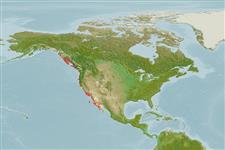Environment: milieu / climate zone / depth range / distribution range
Ökologie
seewasser; ozeanodrom (Ref. 51243); tiefenbereich 0 - 18 m (Ref. 2850). Temperate; 58°N - 24°N, 155°W - 111°W
Eastern Pacific: Alaska to Magdalena Bay, Baja California. Not common north of Point Conception (Ref. 11484).
Size / Gewicht / Alter
Maturity: Lm ? range ? - ? cm
Max length : 145 cm FL Männchen/unbestimmt; (Ref. 40637); max. veröff. Gewicht: 12.0 kg (Ref. 40637); max. veröff. Alter: 12 Jahre (Ref. 56049)
Rückenflossenstacheln (insgesamt): 6; Rückenflossenweichstrahlen (insgesamt): 9-10; Afterflossenstacheln 1; Afterflossenweichstrahlen: 8 - 9. Color bluish or brownish dorsally, silvery ventrally (Ref. 6885).
Usually near shore or near the surface (Ref. 2850). Often in small schools (Ref. 2850). Young enter bays (Ref. 2850). Feed mainly on other fishes (Ref. 2850). Pelagic spawners (Ref. 56049). Migrate south from the California coast during autumn, but may remain in front of the Mexican coast throughout the year (Ref. 9345). Utilized fresh, dried or salted and frozen; eaten broiled and baked (Ref. 9988). Considered as potentially dangerous due to its large, sharp teeth and aggressive disposition, though there are no reports of attacks (Ref. 9988).
Pelagic spawner (Ref. 56049).
Eschmeyer, W.N., E.S. Herald and H. Hammann, 1983. A field guide to Pacific coast fishes of North America. Boston (MA, USA): Houghton Mifflin Company. xii+336 p. (Ref. 2850)
IUCN Rote Liste Status (Ref. 130435)
Bedrohung für Menschen
Traumatogenic (Ref. 13513)
Nutzung durch Menschen
Fischereien: kommerziell; Sportfisch: ja
Mehr Information
PartnerBilderStamps, Coins Misc.LauteCiguateraGeschwindigkeitSchwimmstilKiemenoberflächeOtolithsGehirngrößeSehfähigkeit
Tools
Zusatzinformationen
Download XML
Internet Quellen
Estimates based on models
Preferred temperature (Ref.
123201): 8.9 - 23.1, mean 12.4 °C (based on 212 cells).
Phylogenetic diversity index (Ref.
82804): PD
50 = 0.5000 [Uniqueness, from 0.5 = low to 2.0 = high].
Bayesian length-weight: a=0.00724 (0.00339 - 0.01546), b=2.92 (2.74 - 3.10), in cm total length, based on LWR estimates for this Genus-body shape (Ref.
93245).
Trophic level (Ref.
69278): 4.5 ±0.80 se; based on food items.
Generation time: 7.9 ( na - na) years. Estimated as median ln(3)/K based on 1
growth studies.
Widerstandsfähigkeit (Ref.
120179): mittel, Verdopplung der Population dauert 1,4 - 4,4 Jahre. (K=0.14; tm=2-3; tmax=12; Fec=42,000).
Fishing Vulnerability (Ref.
59153): High to very high vulnerability (69 of 100).
